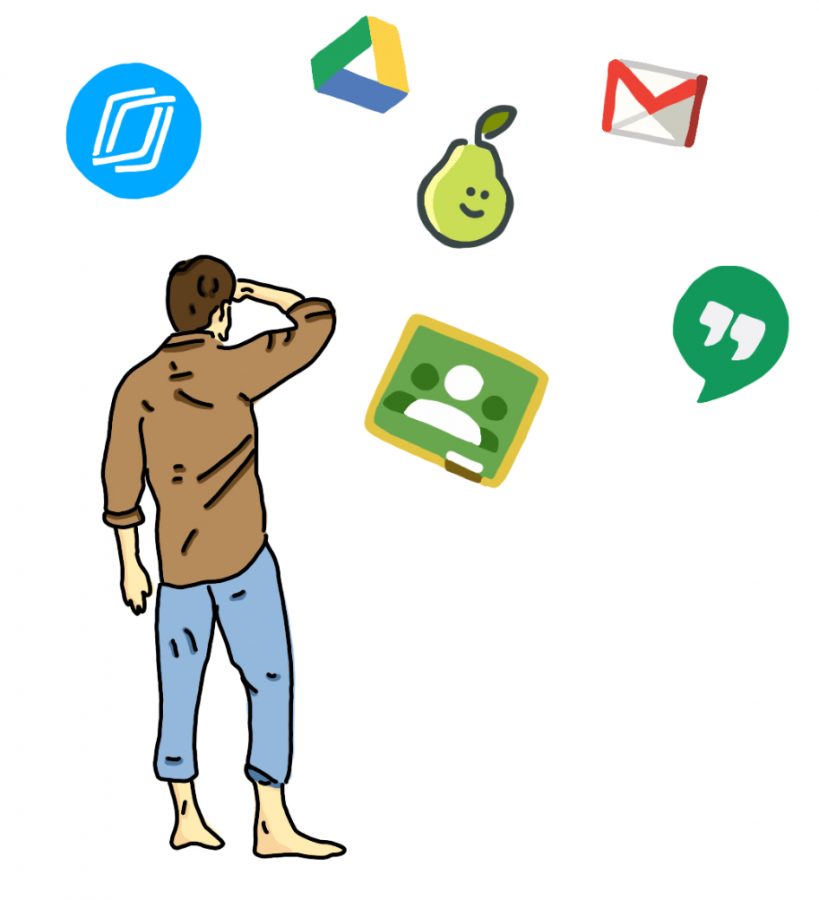Troubles with distance learning
Remote learning forces teachers to quickly alter their curriculums and use unfamiliar technology
Jones teachers have faced their own set of unique problems as school communities adjust to remote learning.
After CPS announced less than a month before the first day of school that all classes would take place online, teachers had little time to familiarize themselves with a variety of technology platforms and find ways to engage their students through a screen.
At first, the expectation to teach from a computer was overwhelming.
“It made the first couple of weeks really stressful,” said Kyle Eck, who teaches Math 4B and Multivariable Calculus. “I remember really wanting to plan ahead, because that’s what I like to do, and not being able to, because I didn’t know the specifics and particulars.”
Anxiety towards remote teaching is common amongst Jones staff. Nora Bingham, who teaches AP Government and Honors U.S. History classes in her second year at Jones, said she felt especially underprepared because she does not consider herself ‘super tech-savvy.’
“I started using Pear Deck this week. Next week we’ll do breakout rooms. It’s like a puzzle, piece by piece,” says Bingham. “I’ll get there, but I did not feel prepared. It’s nobody’s fault; it’s just because it’s hard.”
Teachers say that adapting classes for an online format has proven time-consuming as well as overwhelming.
Kimberly Bowman, who teaches AP Calculus AB and Honors Probability and Statistics, said, “For calculus, I have had to digitize all my assessments, which has been the bulk of my work, along with using Screencastify to record lectures for asynchronous learning.”
Jones math classes normally prioritize group work, but virtual learning has made them largely individual.
“Talking with each other, struggling, and learning from others is out the window, and students are kind of more on their own to self-study,” said Eck. “It’s kind of almost the opposite of how I would structure class normally.”
Although the rapid transition to distance learning was tricky, Jones teachers are in this together. Bingham said course group chats email groups have been helpful, and teachers share new technology platforms they find and help troubleshoot common problems.
“We can all kind of crowdsource and help each other in a large group chain,” said Bingham.
Still, most teachers feel that remote learning isn’t sustainable or comfortable.
“I don’t like being on camera. I hate this,” said Mary Ann Siegel, an American and World Literature teacher. “They send recordings of our meets; if I open it up and I listen to my own voice, it’s enough to make me go ‘I don’t want to teach.’ It’s always something that’s now in my periphery of thinking that wasn’t there before.”
Along with feeling uneasy about teaching through a screen, teachers say they are concerned about their students’ engagement and wellbeing while they are confined to this virtual format.
“I was worried about the effects of too much screen time on people, young and old,” said Brady Gunnink, an AP Lang and AP Seminar teacher.
Gunnink also says the limitations of the platforms CPS allows teachers to use are challenging to work around.
“I made bootleg breakout rooms. That took a lot of work, I had to open up five or six different Google Meets, which slowed down my computer so much the first time that I could not even make it happen.”
Before Google Meets was updated to include breakout rooms, Gunnink says he borrowed his wife’s laptop to facilitate breakout sessions in his classes.
“It was a big mess, but it worked,” stated Gunnink.
Bowman feels that other technology options that aren’t available to CPS teachers would work better for her classes.
“I would probably use Zoom instead of Google Meet one hundred percent. I think Zoom is a faster interface, I think it just has better connectivity.”
Ms. Siegel says the limited technology options CPS has given teachers have affected her classes too.
“We’re working with a really big organization. And we’re working in a pandemic, so everything just takes longer, and I think there’s probably a lot of things they are looking at to be approved.”
Students say technology causes delays on their end of the Google Meet too.
“I wish they would slow down just a little bit. Because like, sometimes my computer takes a long time to load. My brain takes a long time to load,” said Ariana Abimbola ’22.
Despite the gloomy aspects of teaching ‘in the void’ as Bowman puts it, Jones teachers also shared messages of optimism.
“I really like Pear Deck. It’s super easy, so if you’re a teacher like me who’s afraid of technology, it’s super easy,” said Bingham. “I have found it to be very intuitive and very easy to use, and it has increased participation in all of my classes.”
Gunnink said he is still able to find moments of joy during class that make it worth it to teach online.
“Just getting these little bursts of enthusiasm. Somehow in this soul-sucking format, there’s still some intellectual joy and curiosity to be had,” said Gunnink. “Those are the moments that keep me going.”

Whitney is excited to continue at the Blueprint as Associate Editor of Print during their senior year at Jones. She also participates in National English...







